On a Five-Dimensional Chaotic System Arising from Double-Diffusive Convection in a Fluid Layer
Abstract
A chaotic system arising from double-diffusive convection in a fluid layer is investigated in this paper based on the theory of dynamical systems. A five-dimensional model of chaotic system is obtained using the Galerkin truncated approximation. The results showed that the transition from steady convection to chaos via a Hopf bifurcation produced a limit cycle which may be associated with a homoclinic explosion at a slightly subcritical value of the Rayleigh number.
1. Introduction
The concept of sensitivity on initial conditions where a small difference on initial conditions may produce large variations in the long-term behaviour of the system is pivotal in chaos theory. This behaviour is also known as the “butterfly effect” related to work done by Lorenz [1] where it is already described by Henri Poincare in 1890 in the literature in a particular case of the three-body problem. Chaotic behaviour has been studied intensively in various dynamical systems; see, for example, [2–14].
The investigation of free convection in the Rayleigh-Bénard problem is receiving much attention due to its wide application in different disciplines such as biotechnology for the description of the convection with the microorganisms diffusion, in astrophysics for simulation of the influence of the helium diffusion on convective motions in the stars, in oceanography for the investigation of the salinity influence on the convective motions in the seas, and in engineering and geology. Research in double-diffusive convection begins after the work done by sea-going oceanographers in order to measure the fluctuation of temperature and salinity as a function of depth as stated in the paper of Huppert and Turner [15]. Then, Knobloch et al. [16] and Bhattacharjee [17] studied the transition to chaos in double-diffusive convection with stress-free boundary conditions where oscillatory solution exists. They showed that the instability of fluid becomes oscillatory when thermal Rayleigh number is raised and the truncated model suggests that the appearance of chaos is associated with heteroclinic bifurcations.
Two-dimensional thermosolutal convection between free boundaries was studied numerically by Veronis [18]. From their observation, they found that when the solutal Rayleigh number is large enough, the oscillations underwent a bifurcation to asymmetry as thermal Rayleigh number increased and, for the larger values of solutal Rayleigh number, the transition from chaos to steady motion occurs.
Sibgatullin et al. [19] studied some properties of two-dimensional stochastic regimes of double-diffusive convection in a plane layer. Using the Bubnov-Galerkin method, they obtained that, with the growth of Rayleigh numbers of heat and salinity, the structure of one-dimensional curve becomes more irregular and sophisticated. Transition to chaos in double-diffusive Marangoni convection was studied by Li et al. [20]. It was found that the supercritical solution branch takes a quasiperiodicity and phase locking route to chaos while the subcritical branch follows the Ruelle-Takens-Newhouse scenario. The transitions from regular to chaotic dynamics and analysis of the hyper, hyper-hyper, and spatial-temporal chaos using the Lyapunov exponents of continuous mechanical systems have been studied in [21–24]; they found the Sharkovskii windows of periodicity in the systems investigated.
The objective of the present paper is to study the weak turbulence and chaos in double-diffusive convection involving temperature and concentration as the thermal Rayleigh number increases with rigid, no-slip horizontal boundary condition. Applying the truncated Galerkin approximation to the governing equations yields an autonomous system with five ordinary differential equations which can be used to understand low-dimensional dynamics before moving to studying more complex systems.
2. Mathematical Formulation
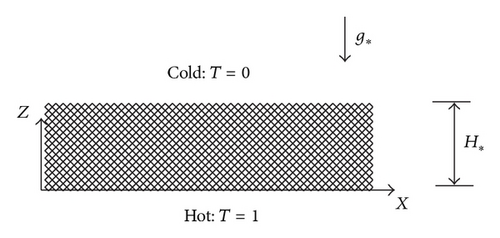
In this model, all the boundaries are rigid and the solution must follow the impermeability conditions there, that is, on the boundaries, where is a unit vector normal to the boundary. The temperature and solute concentration boundary conditions are T = S = 1 at z = 0 and T = S = 0 at z = 1.
3. Diminished Set of Equation
4. Linear Stability Analysis
In this paper, we investigate the chaotic behaviour with low Prandtl number in double-diffusive convection. We obtained system (12) that provides a set of nonlinear equations with five parameters. The value of λ has to be consistent with the wave number at the convection threshold, a requirement for the convection cells to fit into the domain and fulfill the boundary conditions. However, the Lorenz equations have been extensively analyzed and solved for parameter values corresponding to convection in pure fluids and, even there, the parameter values most regularly used correspond to Pr = 10 and λ = 8/3. Therefore, it is of interest to analyze and solve the corresponding equations for parameter values corresponding to the problem under investigation. We employ the MATLAB ODE45 routine for obtaining the numerical solutions.
Before attempting the numerical solution of system (12), it is useful to examine the local stability of equilibrium points. System (12) has the three basic properties which we will discuss in the following: dissipation, fixed points, and stability of fixed points.
4.1. Dissipation
4.2. Fixed Points
4.3. Stability of the Fixed Points
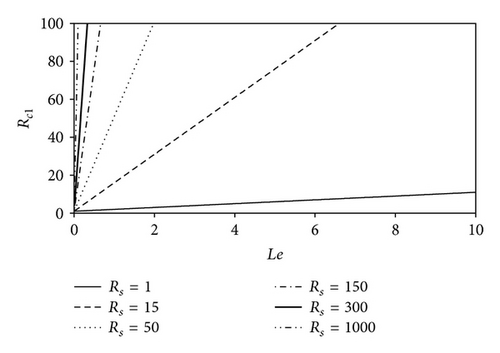
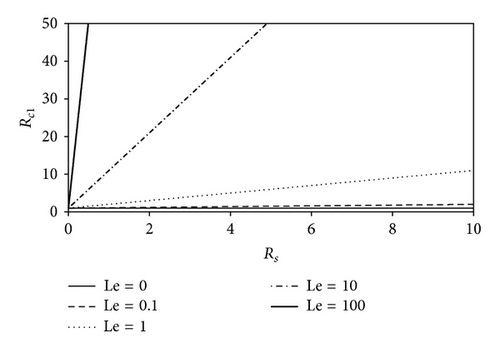
The stability of the fixed points (Xi, Yi, Zi, Ui, Wi) (i = 2, …, 5) is associated with the convective solution. The evolution of the complex eigenvalues of J in the case Pr = 10, λ = 8/3, and Le = 0.1 is plotted as shown in Figure 3(a) for the fixed point (X4,5, Y4,5, Z4,5, U4,5, W4,5). These two roots become a complex conjugate at R≃ 3.32, 3.97, 4.63, and 5.28 for the case Rs = 15, 20, 25, and 30, respectively. At these points exactly, they still have negative real parts; therefore, the convection fixed points are stable, that is, spiral nodes. Of all the cases, both the imaginary and real parts of these two complex conjugate eigenvalues increase as R increases and they cross the imaginary axis on the complex plane, so as a result their real part becomes nonnegative at a value of Rc2≃46.37, 57.34, 69.33, 82.18. At these points, the convective fixed points lose their stability and another periodic, quasiperiodic or chaotic solution takes over. Figure 3(b) shows the evolution of the complex eigenvalues of J for the case Pr = 10, λ = 8/3 and Rs for the fixed point (X4,5, Y4,5, Z4,5, U4,5, W4,5). These two roots become a complex conjugate at R≃3.33, 5.23, 7.03, 8.73 for the case of Le = 0.1, 0.2, 0.3, 0.4, respectively. As mentioned before, the convection fixed points are stable and become spiral nodes. Their real part becomes nonnegative at a value of Rc2≃31.71, 34.96, 40.05, 46.37. Therefore, at these points, the convective fixed points lose their stability and another periodic, quasiperiodic, or chaotic solution takes over.
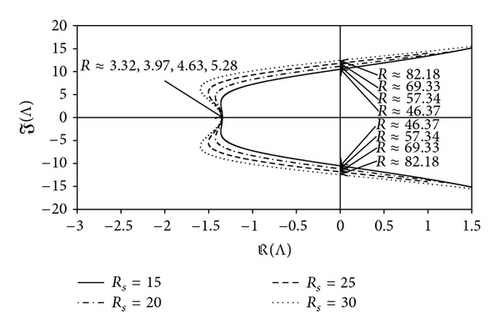
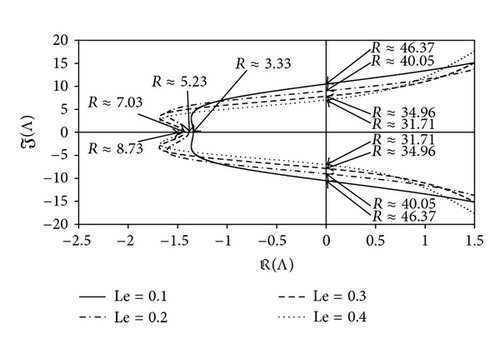
While for the fixed point (X2,3, Y2,3, Z2,3, U2,3, W2,3), the evolution of the complex eigenvalues of J with the same parameter values is always on the positive side of Re(Λ), does not cross the zero axis for Re(Λ), and is not of interest in this study.
5. Results and Discussion
5.1. Bifurcations and Transition to Chaos
In this study, we focused on the dynamic behaviour of thermal convection in double-diffusive fluid layer. The values of Pr and λ used in all computations are 10 and 8/3, respectively, which are consistent with the critical Rayleigh number (Rc≃24.74) and the critical wave number at marginal stability in fluid layer convection. All solutions were obtained using the same initial conditions, which were selected to be in the neighborhood of the positive convection fixed point. The initial conditions are at τ = 0 : X, Y, Z, U, W = 0.9. All computations were carried out with the value of maximum time, τmax = 210, and a step size Δτ = 0.001 using the built-in ODE45 method in MATLAB R2010a.
The bifurcation diagrams illustrated in Figure 4 show the peaks and valleys in the posttransient values of Z versus R. In Figure 4(a), for 0 < R < 46.37 we have one-point attractors, but the “attracted” value of Z increases as R increases, at least to R≃46.37. Bifurcation occurs at R≃46.37,48 until just beyond R = 50, where the system is chaotic. However, the system is not chaotic for all values of R > 50, and we will discuss it using phase-portrait diagram. When we fix Le = 0.1 and increase Rs from 15 to 30, the range of one-point attractor changes to 0 < R < 82.31; this is shown in Figure 4(b), while in Figure 4(c), one-point attractor dropped to 0 < R < 31.86 in the case of Le = 0.4 and Rs = 15. Here we can conclude that increasing the value of the solutal Rayleigh number (with fixed value of Lewis number) will delay the convection process. But increasing the value of Lewis number (with fixed value of solutal Rayleigh number) will enhance the onset of chaos.
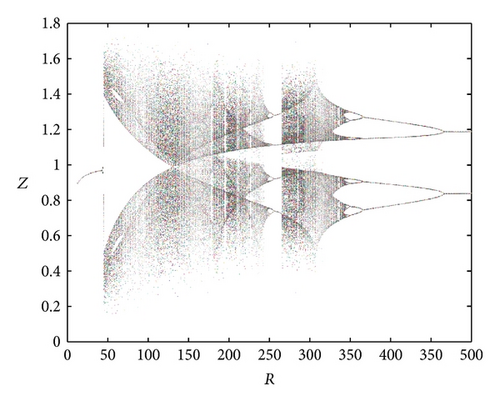
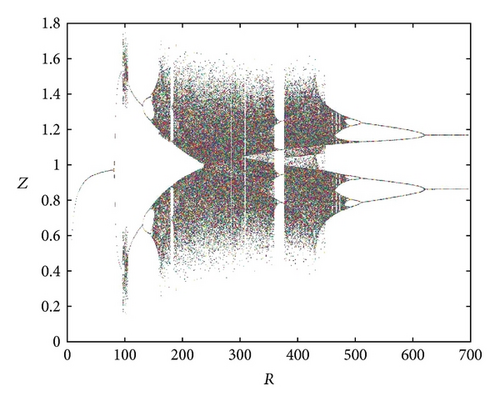

Figure 5 shows the projections of the trajectory’s data points on the X-Y-Z plane for Le = 0.1 and Rs = 15. From Figure 5(a), we obtain a solitary limit cycle signifying the loss of stability of the steady convective fixed points. The subcritical value for this transition is Rc2 = 46.37. Figure 5(b) shows the projections of the trajectory’s data points for R = 48. At this point, the homoclinic explosion occurs and the chaotic regime with the strange attractor takes over. The homoclinic explosion behaviour giving birth to a stable periodic orbit with period-8 at R = 250 is presented in Figure 5(c). This corresponds to the first wide periodic window within the chaotic regime. In Figure 5(d) we can observe that the data points do align in such a way as to produce an almost clear projection of unconnected points on the projected plane. Increasing the value of R further shows the dynamical behaviour’s return to being chaotic again at R = 300 as shown in Figure 5(e). At R = 360 and R = 400, we have a period-8 and period-4 periodic solutions as shown in Figures 5(f) and 5(g). Figure 5(h) shows that a period-2 periodic solution takes over at R = 500 and a period-2 periodic type remains when the solutions at higher values of R are obtained. We conclude the observation around these regimes of periodic windows within the broadband of chaotic solutions by pointing out a sequence of period-halving as one increases the Rayleigh number.
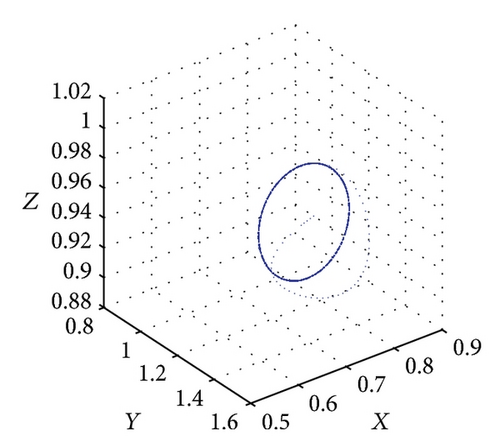
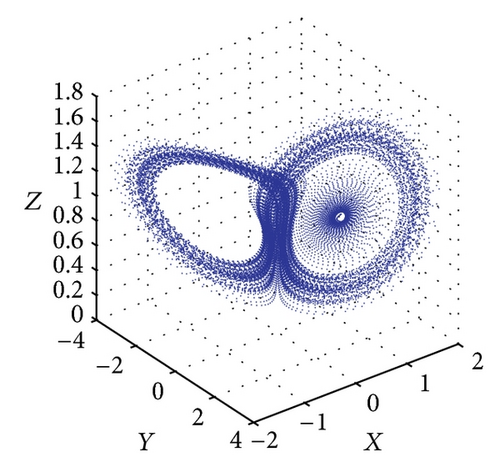
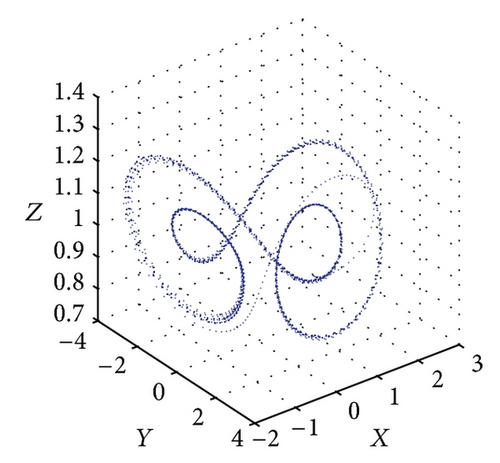
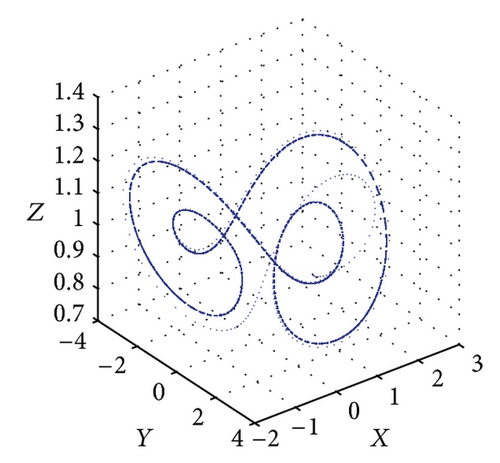
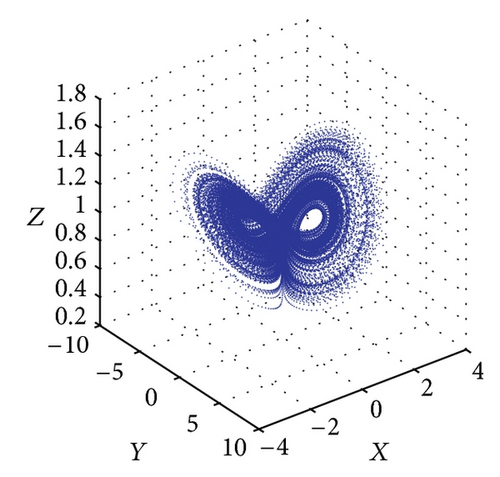
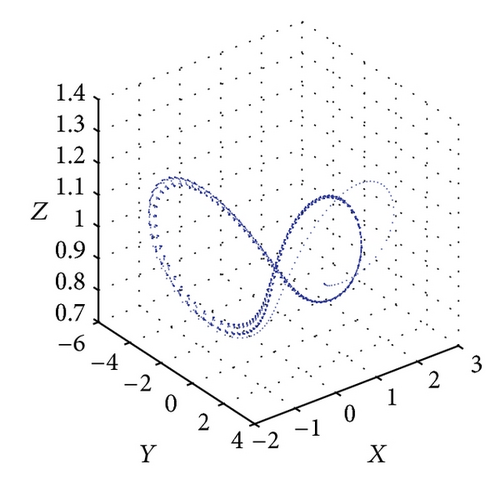
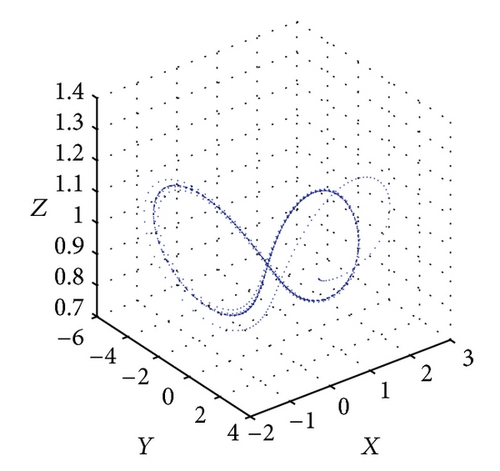
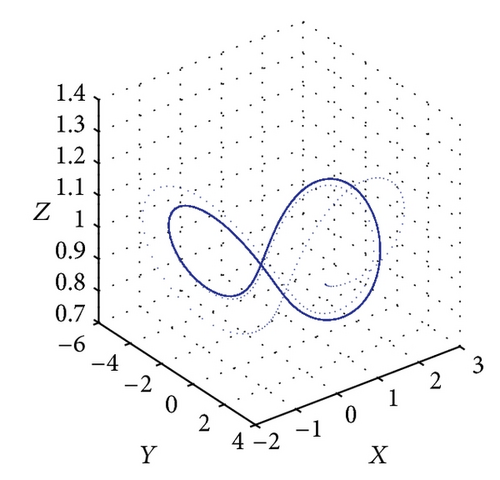
Figure 6 shows the projections of the trajectory’s data points on the X-Y-Z plane for Le = 0.1 and Rs = 30. The subcritical values for limit cycle and homoclinic explosion occur at Rc2 = 82.18 and R = 98 as shown in Figures 6(a) and 6(b), respectively, while period-8 is observed at R = 364 and 370 as presented in Figures 6(c) and 6(d). The dynamical behaviour returns to being chaotic again as R increases; this happens at R = 400 as shown in Figure 6(e). Figures 5(f) and 5(g) show a period-8 and period-4 periodic solutions at R = 490 and R = 500. Figure 6(h) shows that a period-2 periodic solution takes over at R = 600 and remains the same behaviour when the solutions at higher values of R are continued.
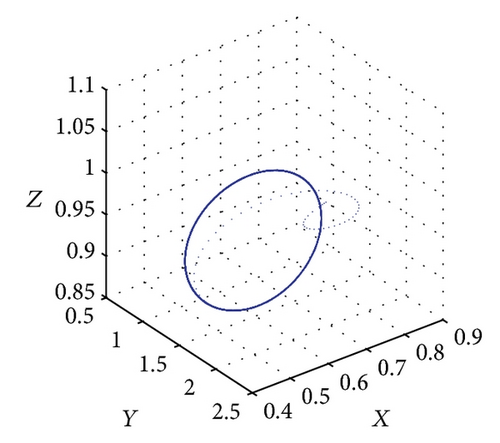
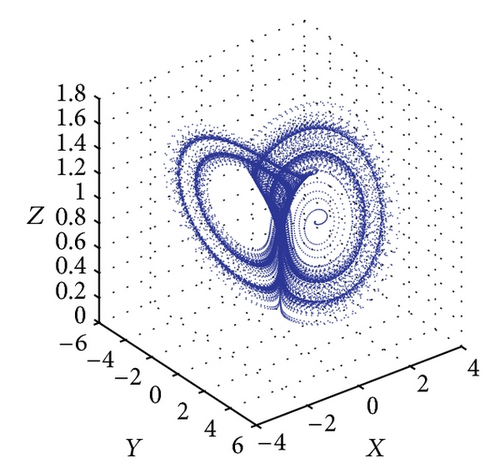
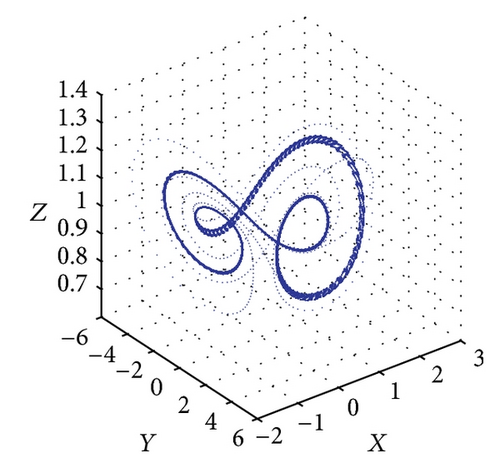
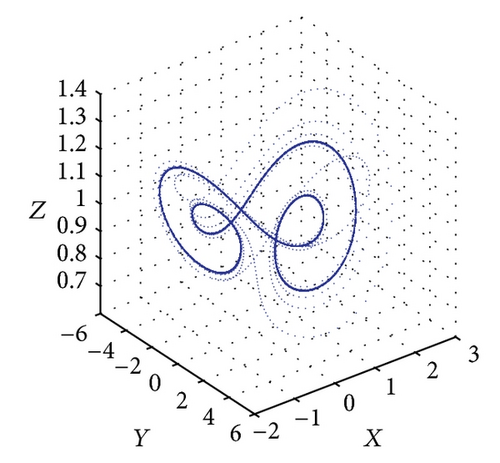
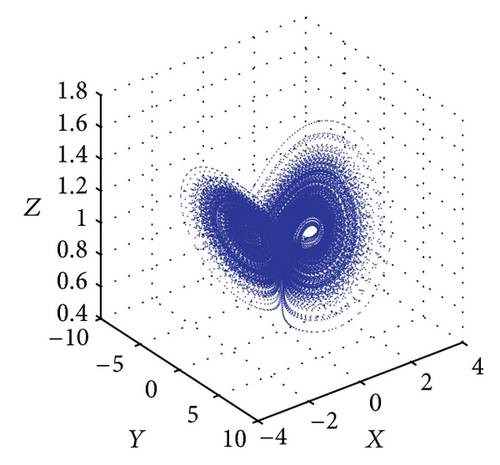
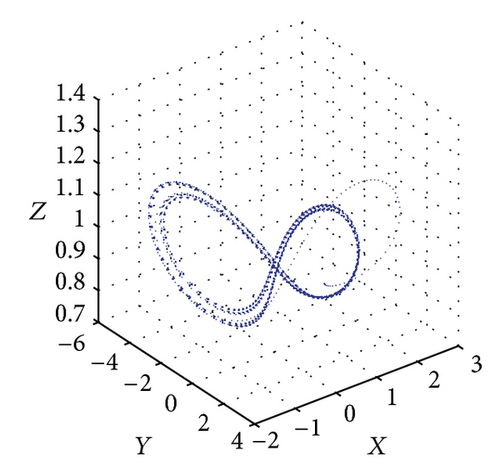
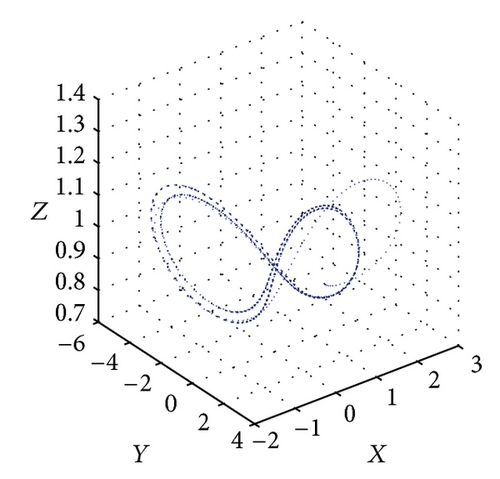
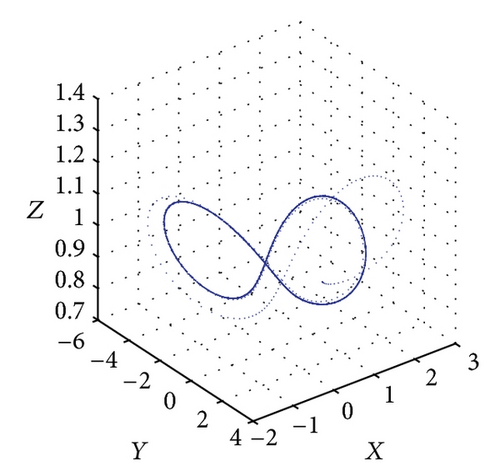
5.2. Lyapunov Exponents
The convergence plot of the Lyapunov spectrum for system (12) is shown in Figure 7. The alogrithm as proposed by [24] was employed for this purpose. The values of the Lyapunov exponents for system (12) are tabulated in Table 1. From these results, we can conclude that for eigenvalue λ1 the system is always unstable and chaotic with the increasing R. For λ2, the system alternates between being stable and dissipative to unstable and chaotic when the value of R is increased. For eigenvalues λ3, λ4, and λ5, the system is always stable and dissipative with the increasing R.
| R | λ1 | λ2 | λ3 | λ4 | λ5 |
|---|---|---|---|---|---|
| 46.37 | 2.674585 | −3.572664 | −7.683913 | −12.847196 | −28.904144 |
| 48 | 2.612254 | −3.302684 | −7.921422 | −12.710783 | −29.010697 |
| 260 | 6.350478 | 0.626358 | −4.509057 | −13.941471 | −38.856433 |
| 300 | 7.469197 | −0.458284 | −4.653033 | −14.610687 | −38.076093 |
| 360 | 8.589279 | 0.219833 | −4.754681 | −15.043590 | −39.338205 |
| 400 | 8.404066 | −0.611687 | −4.530720 | −12.889258 | −40.698489 |
| 500 | 4.451812 | 4.442320 | −3.196173 | −12.386501 | −43.632794 |
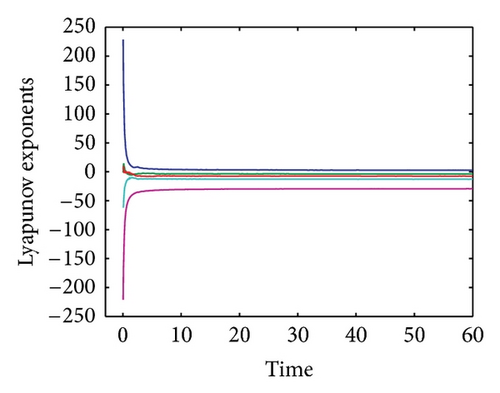
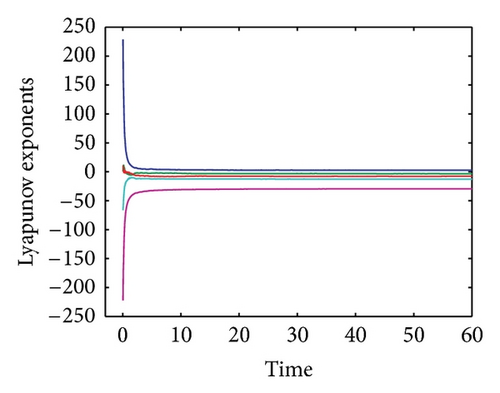
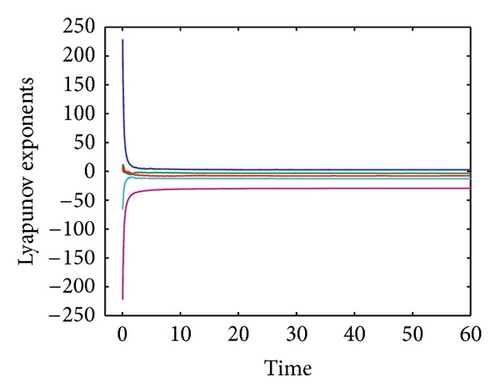
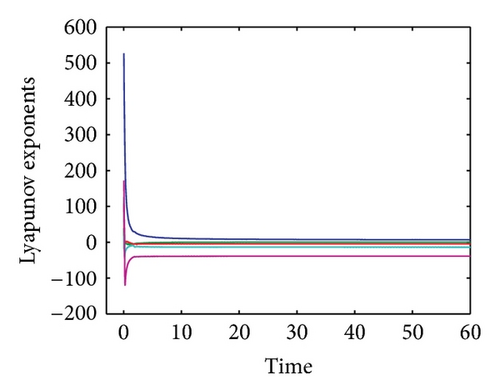
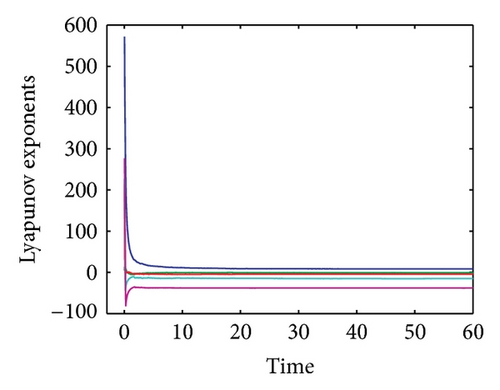
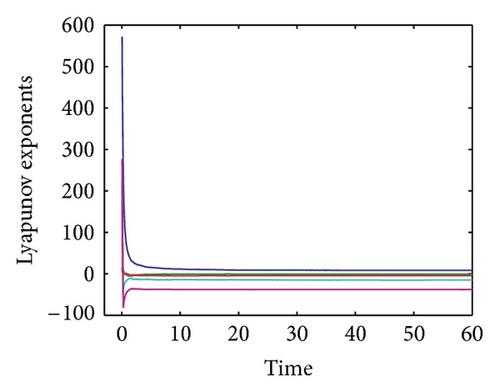
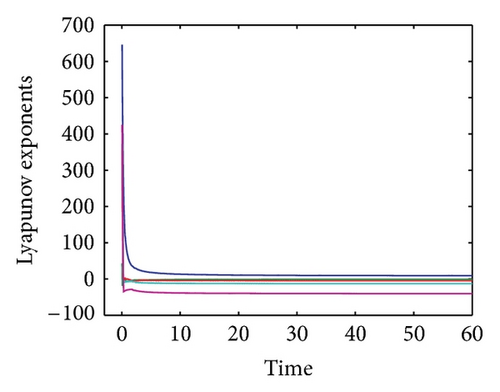
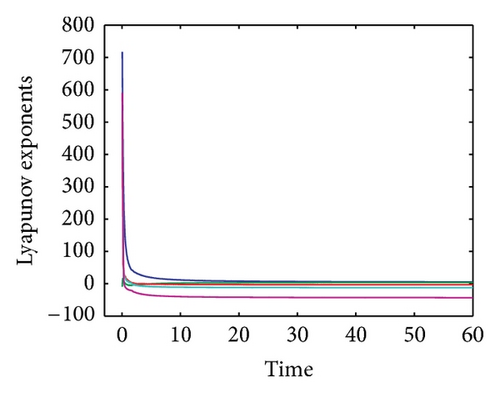
6. Conclusion
In this work, chaotic behaviour in double-diffusive convection in a fluid layer has been investigated. A five-dimensional model of chaotic system was obtained using the Galerkin truncated approximation. The transition from steady convection to chaos via a Hopf bifurcation produced a limit cycle which may be associated with a homoclinic explosion at a slightly subcritical value of the thermal Rayleigh number. Both the solutal Rayleigh number and Lewis number affect the stability of the system. Increasing the Rayleigh number shows that the trajectory of the data points pointing out a sequence of period-halving and the behaviour remains the same at a higher Rayleigh number. The different transitions of the system, can be implied by the different values of the Lyapunov exponents. Negative eigenvalues lead to a stable and dissipative system and positive eigenvalues show that the system is always unstable and chaotic, while alternate eigenvalues suggest different transitions of the system (i.e., stable and dissipative to unstable and chaotic) as the value of the Rayleigh number is increased.
Acknowledgments
The authors acknowledge the financial support from Universiti Malaysia Terengganu (Grant no. TPM-68006/2012/49), Universiti Kebangsaan Malaysia (Grant no. DIP-2012-12), and University of Malaya (Grant no. RG172-11AFR).




